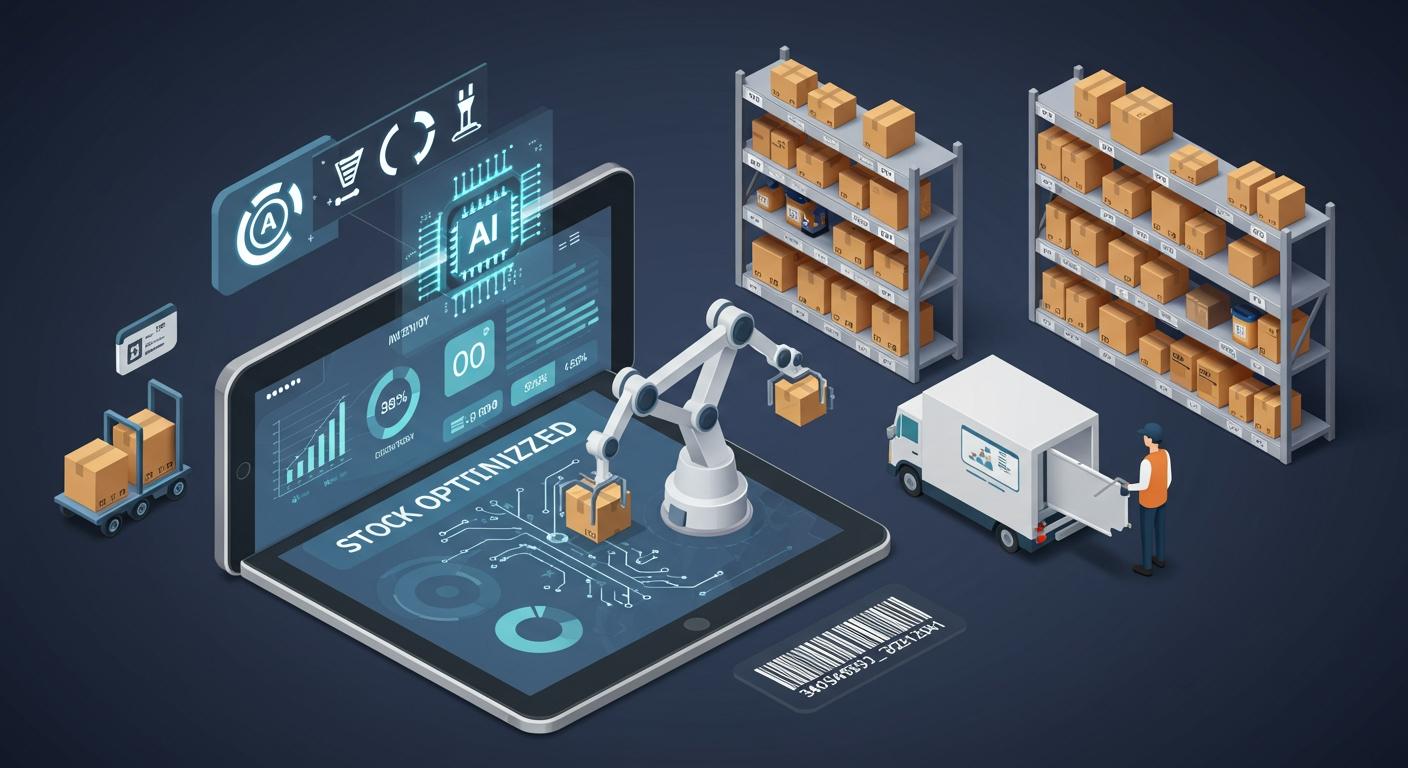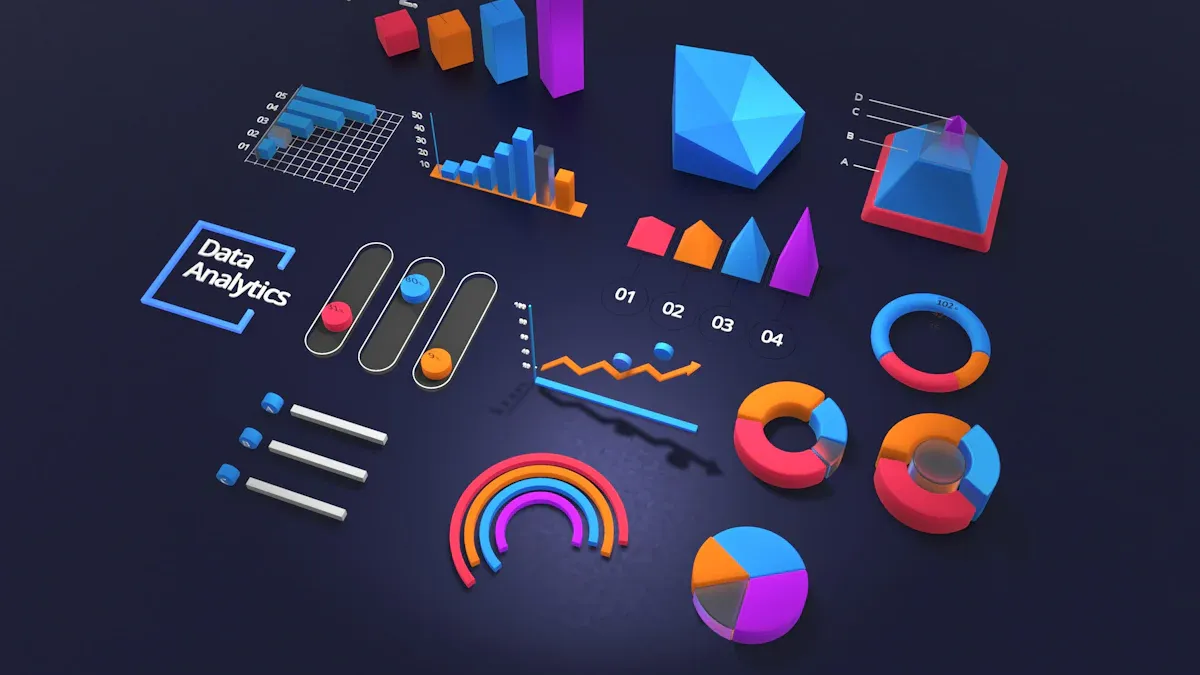AI Predictive Inventory: Never Run Out of Stock Again

AI Predictive Inventory uses clever analytics and automation to keep shelves stocked. You do not need to worry about missing popular items. Think about this: one online shop saw stockouts fall by 85% in only three months after using AI. StyleLab Apparel also lowered stockouts by the same amount during their busiest sales times. If you want your business to run better and customers to be happier, AI Predictive Inventory can help you stay ahead.
Key Takeaways
AI Predictive Inventory uses smart technology to keep shelves full. It helps reduce stockouts by up to 85%.
The system learns from sales data and market trends. This lets it predict demand very well.
Automated reordering makes sure you never run out of popular items. It saves you time and effort.
Real-time inventory tracking helps you act fast when stock levels change.
Using AI can save a lot of money. It does this by keeping stock levels right and cutting down on waste.
Happy customers will come back if you always have what they want.
Before you use AI, check your data quality. Set clear goals for what you want to do.
Pick an AI solution that fits your business needs. Make sure it works well with your current systems.
AI Predictive Inventory
Definition
You may wonder how AI Predictive Inventory is different from old stock methods. This system uses artificial intelligence and machine learning to keep shelves full. It helps your business run well. You do not have to guess or check stock by hand anymore. The smart system learns from your sales, market trends, and customer behaviour. It helps you decide what to order and when.
Let’s look at how AI Predictive Inventory and traditional inventory management are different:
Aspect | AI Predictive Inventory | Traditional Inventory Management |
|---|---|---|
Data Utilisation | Uses real-time data and advanced algorithms | Relies on manual tracking and historical data |
Demand Prediction | Often leads to inaccuracies and missed sales | |
Stock Monitoring | Continuous real-time monitoring | Manual checks, prone to errors |
Efficiency | Optimises stock levels and reduces costs | Often inefficient, leading to overstock or shortages |
With AI Predictive Inventory, you can see trends as they happen. The system finds patterns in shopping and market changes. This helps you avoid running out of popular items. You also save money by not buying things that do not sell.
Tip: If you want to stay ahead, using AI Predictive Inventory helps you in today’s fast market.
Core Function
AI Predictive Inventory does more than count your products. It acts like a smart helper and does many jobs for you. Here is what it can do:
Demand Forecasting: The system checks lots of data to guess what customers want next. You get good forecasts and can plan better.
Real-time Inventory Tracking: You always know what is in stock in every shop or warehouse. There are no surprises or last-minute problems.
Automated Reordering: When stock is low, the system can order more for you. You do not have to remember to restock.
Trend Analysis: It finds patterns in your sales and uses them to guess future trends. You can get ready for busy times or sudden changes.
Warehouse Optimisation: The system tells you the best way to arrange products. This makes picking and packing quicker and easier.
Supply Chain Efficiency: You work better with suppliers. The system helps you order the right amount at the right time, so you do not get delays.
Machine learning is very important here. It looks at your old sales and finds patterns you might not see. The system gives advice on how much stock to keep. If you are about to run out, it can order more. If you have too much, it can slow down orders. This stops empty shelves and wasted stock.
You do not need to be a tech expert to use AI Predictive Inventory. The system does the hard work. You can focus on growing your business and making customers happy.
How It Works

It helps to know how AI Predictive Inventory works. This system does more than just count products. It gathers lots of data, finds patterns, predicts what you need, and can even order stock for you. Let’s look at each step.
Data Analysis
Data Sources
You need good data to make smart choices. AI Predictive Inventory collects information from many places, not just sales records. Here are some types of data it uses:
Type of Data |
|---|
Historical Records |
Real-time Sensor Data |
Transaction Logs |
Social Media Data |
You get a clear view of your business. Real-time sensor data, like RFID tags or shelf cameras, shows what is on shelves now. Social media data tells you what people talk about and what is popular. This mix helps you see changes before they become big problems.
Analysing Trends
The system does more than collect data. It looks for patterns and trends. Some products sell more during holidays or weekends. The AI finds these patterns much faster than people can. It checks for sudden rises or drops in sales, which could mean a new trend or a supply problem.
Here is how AI Predictive Inventory compares to manual analysis:
Feature | AI Predictive Inventory | Manual Inventory Analysis |
|---|---|---|
Data Integration | Combines and enriches data from various sources | Often relies on siloed data |
Forecast Accuracy | Provides more accurate demand forecasts | Prone to human error and biases |
Decision-Making Speed | Faster recommendations for stock levels | Slower due to manual calculations |
Frequency of Analysis | Higher frequency for safety stock decisions | Limited by manual processes |
Impact on Costs and Revenue | Reduces inventory costs and increases revenues | May lead to higher costs due to inefficiencies |
You save time and money. The system checks your data all the time, not just once a week or month.
Demand Forecasting
Predictive Algorithms
You do not have to guess what to order next. The AI uses smart algorithms to predict what customers will want. It learns from past sales and current trends. The more data you give it, the better it gets at forecasting.
Here are some methods the system uses:
Method | Description | Example |
|---|---|---|
Data Analysis | Analyses real-time data from POS and social media to track trends | Retailers predicting demand spikes during festive seasons |
Machine Learning | Learns from past behaviour to spot patterns and improve over time | Amazon’s engine predicting customer preferences |
Supply Chain Integration | Connects forecasting with logistics to optimise delivery and procurement | Walmart reordering stock automatically |
Generative AI | Simulates market scenarios for ‘what-if’ analysis | Predicting reactions to new product launches |
You get forecasts that are based on real facts and patterns, not just guesses.
Seasonality and Trends
The system knows that demand changes with the seasons. It checks for things like school holidays, weather changes, or big events. You do not have to remember every special date. The AI tracks these for you and adjusts your stock levels. This means you are ready for busy times and do not waste money on slow periods.
Note: Companies using automated demand forecasting see a 15% improvement in forecast accuracy compared to manual methods. Even a 1% boost in accuracy can cut labour costs by 0.5%. That is a big saving over time.
Automated Replenishment
Purchase Orders
You do not need to watch your stock every day. The system sets up automatic reorder points. When your inventory drops below a safe level, it creates a purchase order for you. Here is what happens behind the scenes:
Process | Description |
|---|---|
Demand Forecasting | Analyses past data to predict what you will need next |
Automated Reorder Triggers | Sets up automatic orders based on predictions |
Stock Optimisation Models | Suggests the best safety stock levels and reorder points for each location |
You can also use data from sales, pricing, and promotions. The system sets up rules for each product, so you do not run out or overstock.
Real-Time Updates
You get real-time updates on your inventory. Technologies like computer vision and IoT sensors make this possible.
Cameras or robots scan your shelves and tell you what is missing.
RFID tags and weight sensors send instant alerts when items are removed.
You always know what is in stock, so you can act fast if something sells out.
Tip: Real-time data means you can spot problems early. You do not have to rely on guesswork or wait for a weekly report.
AI Predictive Inventory takes away the stress of managing stock. It uses event-driven management, so it reacts to changes as they happen. The system also spots unusual patterns, like sudden drops in sales, and alerts you right away. You can focus on growing your business, knowing your inventory is under control.
Benefits

Zero Stockouts
You know how frustrating it feels when you want to buy something, but the shop has run out. With AI Predictive Inventory, you can say goodbye to empty shelves. The system keeps track of what is selling and what is not. It predicts when you will need more stock and makes sure you always have enough. Many companies have seen big improvements after using this technology:
Companies reported a 25% drop in stockouts after switching to AI.
Amazon saw a 35% reduction in stockouts with its predictive system.
A study by IBM found that predictive analytics help businesses cut stockouts and run smoother.
You do not just avoid running out of popular items. You also stop wasting money on things that do not sell. The system checks your stock in real time and reacts fast. You can trust it to keep your shelves full, even during busy times.
Tip: When you never run out of stock, you keep your customers happy and coming back.
Cost Savings
Saving money is always good for business. AI Predictive Inventory helps you cut costs in many ways. It automates boring tasks, so your staff can focus on more important work. It also helps you avoid buying too much or too little. Here is how it works:
What AI Does | How It Saves Money |
|---|---|
Automates routine inventory tasks | Staff spend less time on manual work and more on big ideas |
You do not waste money storing or moving products you do not need | |
Optimises inventory management with smart insights | You run your business more efficiently and cut down on mistakes |
AI-driven forecasting can reduce errors by 20–50% compared to old methods. Some companies have seen up to an 85% jump in forecast accuracy. When you know what to order and when, you save money and avoid surprises.
Customer Satisfaction
Happy customers are the heart of any business. When you always have what they want, they trust you more. AI Predictive Inventory helps you keep your promises. It checks sales trends, holidays, and even social media to make sure you have the right products at the right time.
Customer Satisfaction (CSAT) | Before AI | After AI | Improvement |
|---|---|---|---|
70% | 90% | 20% |
AI-powered systems also spot problems in your shop before they get worse. They alert your team if something needs fixing, so you can act fast. These systems even help you deliver orders quicker by choosing the best route and method. You get fewer complaints and more smiles.
AI Predictive Inventory uses machine learning to spot patterns in your sales. It gives you real-time forecasts, so you can always meet demand. When you keep your customers happy, they are more likely to return and tell their friends.
Note: Even a small boost in forecast accuracy can lead to big savings and happier customers.
Implementation
Readiness
Before you jump into AI predictive inventory, you need to check if your business is ready. Start by looking at your customer journey. Where do your customers face problems? Maybe they cannot find what they want, or you run out of popular items. Map out these pain points. This step helps you see where AI can make the biggest difference.
Next, look at your data. Do you have enough information about sales, stock, and customer habits? Good data is the backbone of any AI system. Make sure your data is clean and easy to access. You also need to check if your business has the right tools to handle this data. If your systems are old or do not talk to each other, you might need an upgrade.
Set clear goals before you start. What do you want to achieve? Maybe you want to cut stockouts by half or improve customer satisfaction. Pick a few key numbers to track, like how often you run out of stock or how quickly you fill orders. These numbers will show if your new system works.
Tip: The more you know about your business problems and your data, the easier it will be to get results from AI.
Solution Selection
Choosing the right AI predictive inventory solution can feel tricky, but you can break it down. Think about what your buyers want and how their needs change. Look at different vendors and see what makes each one special. Some systems might be better for big shops, while others work well for small businesses.
Here is a simple table to help you compare:
Criteria | Description |
|---|---|
Understanding Buyer Needs | Find out what your buyers want and how their needs change over time. |
Evaluating Vendor Capabilities | Check what features and tools each AI solution offers. |
Aligning with High-Value Use Cases | Make sure the system solves your biggest problems and brings real value. |
Pick a solution that matches your main goals. If you want to stop stockouts, choose a system that focuses on demand forecasting. If you want to save time, look for one with strong automation.
Integration
Now you need to fit your new AI system into your current setup. Start by listing all your systems, like your ERP or stock management tools. See how your data moves between them. This step helps you spot any gaps or problems.
Pick an integration platform that works well with your current tools. Some platforms come with ready-made connectors, which makes the job easier. Begin with the most important tasks, like automatic reordering or real-time stock checks. This way, you see quick wins and build trust in the new system.
Set up rules to keep your data safe and reliable. Good data governance means fewer mistakes and smoother operations. Plan for growth, too. Your system should handle more data as your business grows.
Note: Do not forget your team. Train your staff so they feel confident using the new tools. Offer support and answer questions as they come up. When everyone understands the system, you get the best results.
Challenges

Even the best AI predictive inventory system can have problems. You might have trouble with your data, your team, or your technology. Let’s see what these problems are and how you can fix them.
Data Quality
Your AI system needs good data to work well. If your data is messy or old, your predictions will be wrong. You need to use high-quality data for the system to do its job. Here’s why good data is important:
The system’s predictions depend on the quality of your data.
A good data plan helps you manage stock and forecast demand better.
AI models need old sales data and new market trends to make smart choices.
You might have missing details, repeated records, or old information. These problems can cause wrong orders or upset customers. Here’s a quick guide to common data problems and how to fix them:
Data Quality Issue | Example | Impact of Bad Data | Solution |
|---|---|---|---|
Accuracy | Old phone numbers in customer list | Wrong decisions, bad marketing | Check and update your data often |
Timeliness | Late updates for sales records | Bad choices, missed chances | Use automatic updates and syncing |
Consistency | Different records in each system | Confusion, mistakes, more work | Use the same data rules everywhere |
Uniqueness | Same customer listed twice | Wasted time, poor marketing | Remove repeats and link your systems |
Completeness | Missing address details | Late deliveries, unhappy customers | Make sure all forms are filled in |
Tip: Know what data you have now. Check and update it often to keep your system working well.
Change Management
Moving to AI predictive inventory can feel like a big change. Some people might worry about new technology or losing control. You need everyone to work together for the best results.
Here are some ways to help your team:
Show how AI helps your team, not replaces them.
Give training so everyone feels ready to use the new system.
Set small goals and celebrate when you reach them.
When staff know the benefits, they will support the change. Training helps everyone learn new skills and use the system well. Keep talking to your team and listen to their ideas.
Note: Change is easier when everyone feels part of the team and gets help.
Technical Issues
You might have technical problems when you set up your AI system. Sometimes, your data is in different places or uses different formats. You may also need new skills or better ways to manage data.
Here are some common technical problems and what you can do:
Challenge | Description |
|---|---|
Talent, skills, and data | Not enough skilled staff and bad data can slow your project. |
Data unification and contextualisation | Poor data links and bad data make it hard to grow your AI. |
Data fragmentation | Data in many places makes it hard for AI to work well. |
You can fix these problems by doing three things:
Make sure your data is good and easy to find.
Train your team to use the new tools.
Use real-time data links to spot trends and manage stock.
Keep checking how your system works and update it when needed. This helps you avoid problems and get the best from your AI predictive inventory.
Success Stories

Retail
You might wonder how real shops use AI predictive inventory. Many retailers have already made the switch and seen big results. Take a look at some well-known names:
Company | What They Achieved |
|---|---|
Boden | Used AI for smarter decisions on pricing and stock, boosting profits. |
B&M | Swapped Excel for AI, making stock checks faster and more accurate. |
Speedy Hire | Saved 4% on inventory and met 8% more demand without extra stock. |
CMOStores.com | Doubled the number of recommended products bought online. |
You can see that these companies did not just cut stockouts. They also made better choices, saved money, and sold more. When you use AI, you get a clearer view of what your customers want. You can act quickly and keep your shelves full.
Tip: If you want to move away from guesswork, AI predictive inventory gives you the edge.
E-commerce
Online shops face their own challenges. You need to keep up with fast-changing trends and customer demands. AI predictive inventory helps you stay ahead in several ways:
It checks real-time demand signals, so you spot stockouts before they happen.
It looks at past sales and market trends to predict what you will need next.
It automates reordering, so you do not miss out on sales or overstock by mistake.
It brings together data from your whole supply chain, helping you work better with suppliers.
Imagine running an online shop where you never have to worry about running out of your bestsellers. AI helps you keep the right products in stock, even during busy sales or sudden spikes in demand. You spend less time fixing problems and more time growing your business.
When you use AI, you can focus on your customers, not your stockroom.
Manufacturing
Factories and manufacturers have also seen big wins with AI predictive inventory. You can use AI to make your supply chain smarter and your machines more reliable.
Many companies now forecast demand better and keep less extra stock, which means more cash in your pocket and quicker responses to changes.
One large food producer improved their equipment effectiveness by 25% and cut maintenance costs by 30% after using AI to spot problems early.
An automotive company saved over 200 hours of production time by letting AI find machine issues before they caused breakdowns.
You can see that AI does more than just manage stock. It helps you run your whole operation better. You avoid costly delays, keep your production lines moving, and meet customer orders on time.
Note: When you let AI handle the details, you get more time to focus on what matters most—delivering great products.
AI predictive inventory gives you the power to keep your shelves full and your customers happy. You get better forecasts, save money, and make smarter choices every day. Here’s why you should consider it:
You predict demand more accurately and avoid stockouts.
AI grows with your business and helps you scale.
Cloud-based tools are now affordable for everyone.
You make quick, informed decisions.
Small businesses can compete with big brands.
You prepare for the future.
Ready to get started? Just follow these steps:
Pick an AI tool that fits your business.
Clean up your sales and inventory data.
Set up the tool and connect it to your systems.
Test the results and see how it works.
Train your team to use the new system.
Keep checking and improving your setup.
Grow your use of AI as your business expands.
Take the first step today and see how AI can transform your inventory management! 🚀
FAQ
What is AI predictive inventory?
AI predictive inventory uses smart computer systems to help you manage your stock. It looks at your sales and trends. You get better predictions about what to order and when.
Do I need lots of data to start?
You do not need huge amounts of data. You can start with your sales records and stock lists. The more data you add, the smarter the system gets.
Will AI predictive inventory replace my staff?
No, it will not replace your team. It helps your staff work faster and make better choices. You can focus on serving your customers.
How quickly can I see results?
Most businesses see changes in a few weeks. You might notice fewer stockouts and better stock levels after the first month.
Is AI predictive inventory expensive?
Many solutions fit different budgets. Some cloud-based tools cost less than you think. You can start small and grow as your business grows.
Can I use AI predictive inventory with my current systems?
Yes, most AI tools connect with your existing software. You do not need to change everything. Just link the new system to your current setup.
What if my data is not perfect?
Don’t worry if your data is messy. Start by cleaning up what you have. The system can still help you improve over time.
How do I train my team to use AI predictive inventory?
You can use online guides, videos, or vendor training. Start with simple tasks. Let your team ask questions and practise. Everyone learns at their own pace.

TangBuy: A Smarter Way to Dropship in 2025
If you're looking to stay competitive with dropshipping in 2025, speed and trend-awareness are key. TangBuy helps you stay ahead with real-time product trends, fast fulfilment, and factory-direct sourcing. With over 1 million ready-to-ship items, 24-hour order processing, and seamless Shopify integration, TangBuy makes it easier to test, scale, and succeed in today's fast-moving eCommerce landscape.
See Also
Best Selling Hoodies for Profitable Dropshipping in 2025
Lucrative Dropshipping Concepts to Explore in 2025
Essential Strategies for eBay Dropshipping Success in 2025

